The evolution of the cloud has brought big data and the field of machine learning, which is currently receiving a lot of attention as the next big thing. Actually, machine learning has quite an extensive history, with research beginning back in the 1950s. In this article, we’ve assembled a collection of convenient machine learning APIs for you try out.
Prediction API
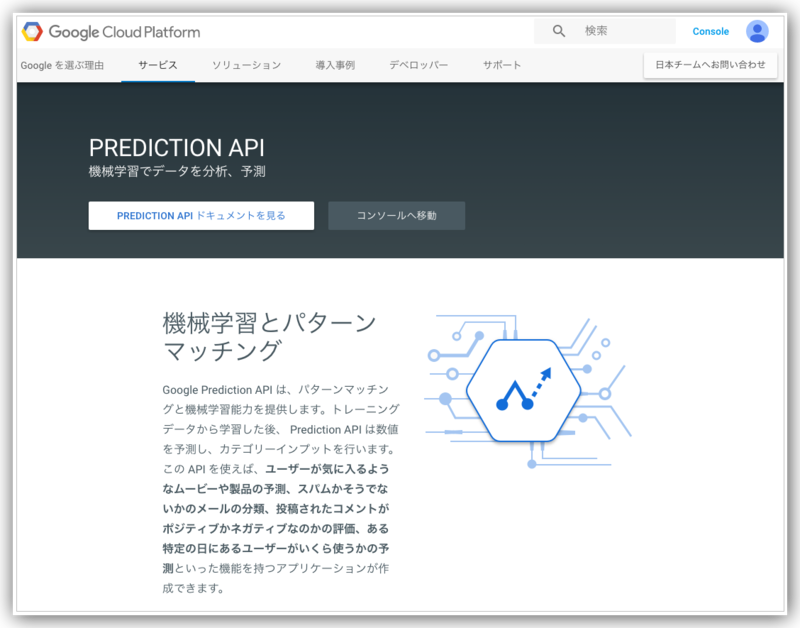
Google’s machine learning service, the Prediction API. Their RESTful API for learning from training data, etc. allows seamless connectivity to Google’s various Cloud Platform services.
The API supports Google Sheets as well—use the Prediction API directly from within your spreadsheets! This is a unique advantage that only Google can bring. Specifically, users need to install an add-on called Smart Autofill. We tried it out, and getting predictions is easy. All you need to do is select the needed cells to get your predictions.
Smart Autofill Spreadsheets Add On
The documentation is mostly in English, but everything is easy to read and understand. The project has only just been open sourced (in November 2015). We’ll likely see more and more information as time goes on.
The pricing structure has free and paid versions. The free tier is more than enough to try things out for yourself. See below for the detailed pricing structure.
The SLA guarantees 99.9% monthly uptime. See here for detailed pricing information.
Microsoft Azure Machine Learning

A machine learning service for Microsoft’s Azure cloud service platform. The most impressive feature is its Machine Learning Studio graphical interface, but users can access the platform via both the GUI and API.
Free users are only allowed to do staging procedures. To switch to a live operating environment and acquire endpoints, users need at least a Standard Plan (explained later) subscription.
The Japanese documentation is largely complete, and both the tutorial and the GIU management information is organized in an easy-to-understand way. There’s an instructional book on sale too—the cost of learning should not be high.
The pricing structure is separate from the Azure platform and divided into Free and Standard Plans. The Standard Plan is completely pay-as-you-go and starts in the ¥1000-¥2000 range. See the pricing details page for more information.
The SLA states that Microsoft guarantees 99.95% availability of API transactions for the Request Response Service (RRS).
Amazon Machine Learning| AWS
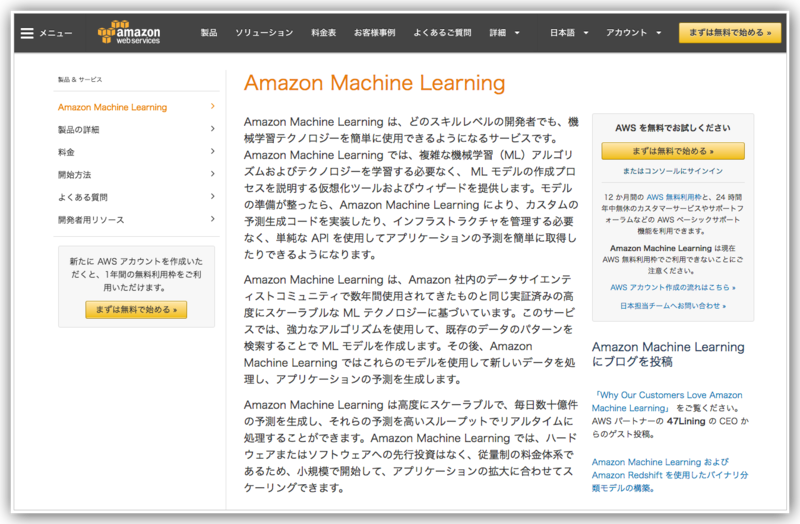
AWS’s analytics service, Amazon Machine Learning.
The documentation is in English and is quite substantial. It is a little difficult to understand, and there are so many services that users may have trouble finding the service they need.
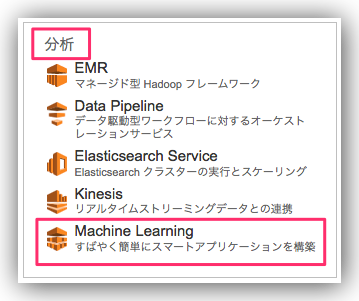
After logging in to the console, first try to find the analytics area. At the time of this article’s writing, availability is restricted to the Eastern US and the EU (Ireland).
You should get a decent idea of how the specifics work by going through the tutorial.

Pricing for AWS is exceedingly difficult to understand, but data analysis and model construction fees are, at $0.42/hour, set higher than other services. For details, please refer to the data analysis and model construction fees.
The AWS Amazon Machine Learning service cannot currently be used with the AWS 12 month free tier trial. We almost missed the warning message. Be careful not to miss this when using their product.
bigml
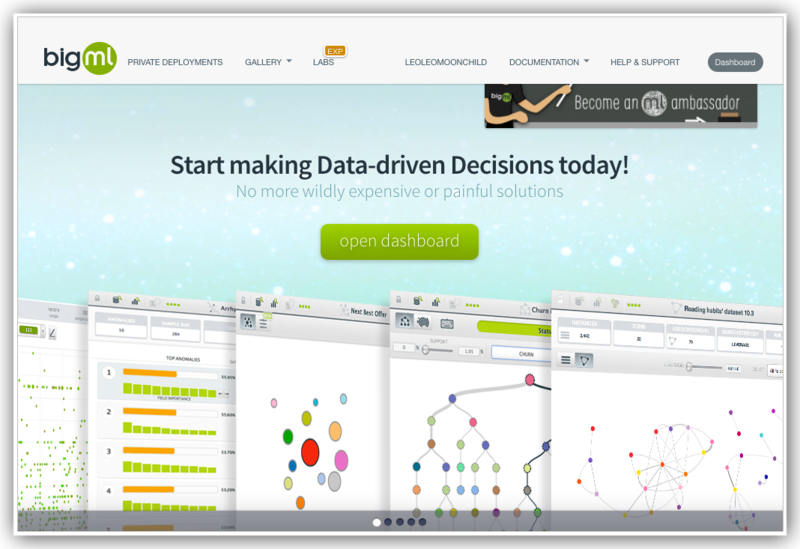
“bigml” is an API service that offers cloud machine learning and predict analytics services. The GIU is easy to use, and the machine learning doesn’t come off as troublesome. Users can get started right away after logging in.
There are several sample datasets prepared. Going through these should give you a general idea of how the platform works.
For Web services, bigml provides a fully controllable RESTful API. The documentation is well-supported, and users should not find themselves getting lost. See the documentation here.
The pricing starts at a monthly plan option for $30 or a yearly plan that, when paid together, costs $240 (calculates to $20 per month). However, be aware that this pricing can change depending on usage and data volume.
indico
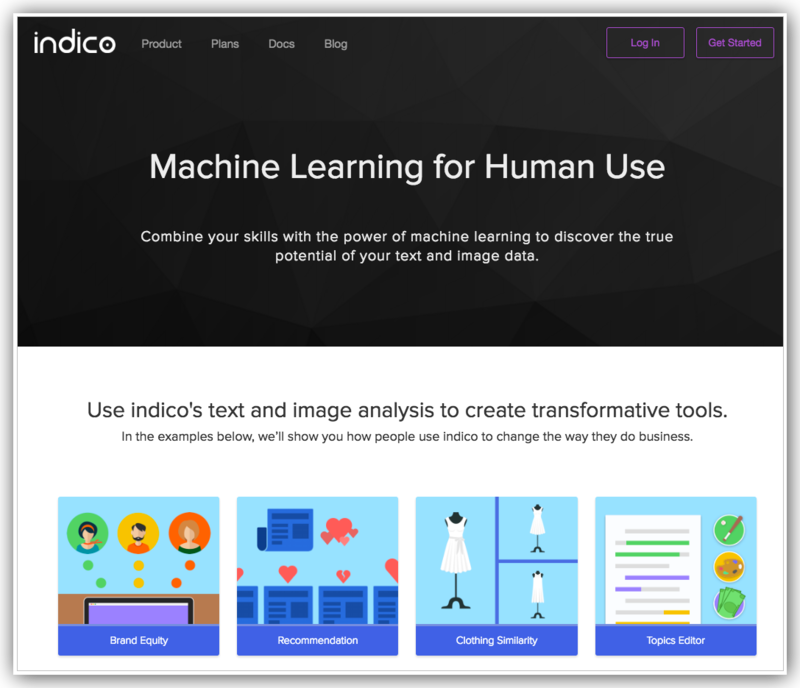
Users are issued an API key after logging in and can use this key to start coding right away. The platform provides code samples for Python, Ruby, Java, NodeJS, PHP and R, so experienced programmers should have no problem getting started.
The below demo is an sample of text sentiment analysis. It includes actual example code that for reference in your own models.
The API is free for up to 10,000 calls per month. There is a fee afterwards, but the amount is on the low side. Furthermore, the system currently only supports English, but the machine learning service API is extremely easy to pick up and use.
Machine learning has an image of being cumbersome and difficult to handle. However, after trying things out myself, we found that things weren’t as bad as we had thought. We were able to implement algorithms like regression analysis and Bayesian filtering without what felt like too
It has become a commonplace and accepted practice for companies to leverage big data to filter data, provide recommendations, etc. The introduced services all have free tiers, so why not give them a whirl when you have the opportunity.
